Oxygen dissociation cu - Study guides, Class notes & Summaries
Looking for the best study guides, study notes and summaries about Oxygen dissociation cu? On this page you'll find 18 study documents about Oxygen dissociation cu.
All 18 results
Sort by
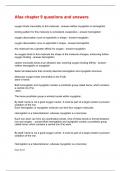
-
oxygen binds irreversibly to this molecule - answer-neither myoglobin or hemoglobin binding pattern for this molecule is considered cooperative - answer-hemoglobin oxygen dissociation curve is hyperbolic in shape - answer-myoglobin oxygen dissociation
- Exam (elaborations) • 5 pages • 2024
- Available in package deal
-
- $9.49
- + learn more
oxygen binds irreversibly to this molecule - answer-neither myoglobin or hemoglobin binding pattern for this molecule is considered cooperative - answer-hemoglobin oxygen dissociation curve is hyperbolic in shape - answer-myoglobin oxygen dissociation curve is sigmoidal in shape - answer-hemoglobin this molecule has a greater affinity for oxygen - answer-myoglobin As oxygen binds to this molecule the shape of the molecule changes, enhancing further oxygen binding - answer-hemoglob...

-
General Chemistry ACS EXAM (2015 version) 60 Questions with Verified Answers,100% CORRECT
- Exam (elaborations) • 16 pages • 2024
-
- $10.99
- + learn more
General Chemistry ACS EXAM (2015 version) 60 Questions with Verified Answers A 20.0 g sample of mercury(II) oxide (HgO, M = 216.6) is heated strongly, causing it to decompose to metallic Hg and O2 gas. What volume of O2 gas is produced (measured at STP)? (A) 1.03 L (B) 2.07 L (C) 4.14 L (D) 14.0 L - CORRECT ANSWER A When 30.0 mL of 0.10 M AgNO3 is added to 30.0 mL of 0.10 M NaCl, aqueous NaNO3 and solid AgCl are formed. How much solid AgCl is produced? (A) 0.0030 mol (B) 0.0...
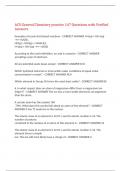
-
ACS General Chemistry practice 147 Questions with Verified Answers,100%CORRECT
- Exam (elaborations) • 15 pages • 2024
-
- $11.99
- + learn more
ACS General Chemistry practice 147 Questions with Verified Answers Examples of Lewis-Acid based reactions - CORRECT ANSWER H+(aq) + OH-(aq) →← H2O(l), HCl(g) + NH3(g) → NH4Cl(s) H+(aq) + OH-(aq) →← H2O(l) According to the Lewis definition, an acid is a species - CORRECT ANSWER accepting a pair of electrons. All are potential Lewis bases except - CORRECT ANSWER CH4 Which hydrated metal ion is most acidic under conditions of equal molar concentration in water? - CORRECT ANS...

-
First Semester Study Guide AP Chem Buck Exam 196 Questions with Verified Answers,100%CORRECT
- Exam (elaborations) • 47 pages • 2024
-
- $12.99
- + learn more
First Semester Study Guide AP Chem Buck Exam 196 Questions with Verified Answers Salts containing which of the following ions are generally insoluble in cold water? a. nitrate b. acetate c. phosphate d. potassium e. ammonium - CORRECT ANSWER C. Phosphate Which of the following changes alone would cause a decrease in the value of Keq for the reaction represented above? a. Decreasing the volume of the reaction vessel b. Adding a catalyst c. Increasing the volume of the reacti...

-
MMSC 409 Final Exam With 100% Correct Answers 2023
- Exam (elaborations) • 19 pages • 2023
- Available in package deal
-
- $18.99
- + learn more
MMSC 409 Final Exam With 100% Correct Answers 2023
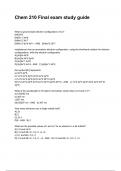
-
Chem 210 Final exam study guide
- Exam (elaborations) • 12 pages • 2024
-
- $10.49
- + learn more
Chem 210 Final exam study guide What is ground state electron configuration of Co? [Ar]3d^9 [Ar]4s^1 3d^8 [Ar]4s^2 3d^7 [Ar]4s^2 4p^6 4d^1 - ANS [Ar]4s^2 3d^7 molybdenum has an anomalous electron configuration. using the shorthand notation for electron configurations, write the electron configuration A) [kr]5s 4d^6 B) [kr]5s 4d^0 5p^6 C) [kr]5s^1 4d^5 D) [kr]5s^2 4d^4 - ANS C) [kr]5s^1 4d^5 the symbol [Kr] represents a) 4s^2 4p^6 b) 1s^2 2s^2 2p^6 3s^6 4s^2 4p^6 c)...
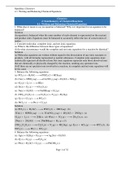
-
Chem1211 Stoichiometry of Chemical Reactions (Writing and Balancing Chemical Equations).
- Exam (elaborations) • 32 pages • 2022
-
- $6.49
- + learn more
Chem1211 Stoichiometry of Chemical Reactions (Writing and Balancing Chemical Equations). 1. What does it mean to say an equation is balanced? Why is it important for an equation to be balanced? Solution An equation is balanced when the same number of each element is represented on the reactant and product sides. Equations must be balanced to accurately reflect the law of conservation of matter. 2. Consider molecular, complete ionic, and net ionic equations. (a) What is the difference betw...
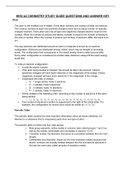
-
HESI A2 CHEMISTRY STUDY GUIDE QUESTIONS AND ANSWER KEY
- Exam (elaborations) • 56 pages • 2022
-
- $15.49
- + learn more
HESI A2 CHEMISTRY STUDY GUIDE QUESTIONS AND ANSWER KEY Atom The atom is the smallest unit of matter. Every atom contains one nucleus at least one electron. The nucleus contains at least one positively charged proton and an equal number of neutrally charged neutrons. Every atom also has at least one negatively charged electron bound to the nucleus. When the number of protons (the atomic number) is equal to the number of electrons, the atom is neutral. When the number of protons and number of ...
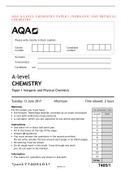
-
AQA A-LEVEL CHEMISTRY PAPER 1 INORGANIC AND PHYSICAL CHEMISTRY
- Exam (elaborations) • 32 pages • 2022
-
- $13.49
- + learn more
AQA A-LEVEL CHEMISTRY PAPER 1 INORGANIC AND PHYSICAL CHEMISTRY A-level CHEMISTRY Paper 1 Inorganic and Physical Chemistry Materials For this paper you must have: • the Periodic Table/Data Booklet, provided as an insert (enclosed) • a ruler with millimetre measurements • a calculator, which you are expected to use where appropriate. Instructions • Use black ink or black ball-point pen. • Fill in the boxes at the top of the page. • Answer all questions....

-
OpenStax Chemistry
- Other • 32 pages • 2023
-
- $8.99
- + learn more
1. What does it mean to say an equation is balanced? Why is it important for an equation to be balanced? Solution An equation is balanced when the same number of each element is represented on the reactant and product sides. Equations must be balanced to accurately reflect the law of conservation of matter. 2. Consider molecular, complete ionic, and net ionic equations. (a) What is the difference between these types of equations? (b) In what circumstance would the complete and net ionic equation...

That summary you just bought made someone very happy. Also get paid weekly? Sell your study resources on Stuvia! Discover all about earning on Stuvia


